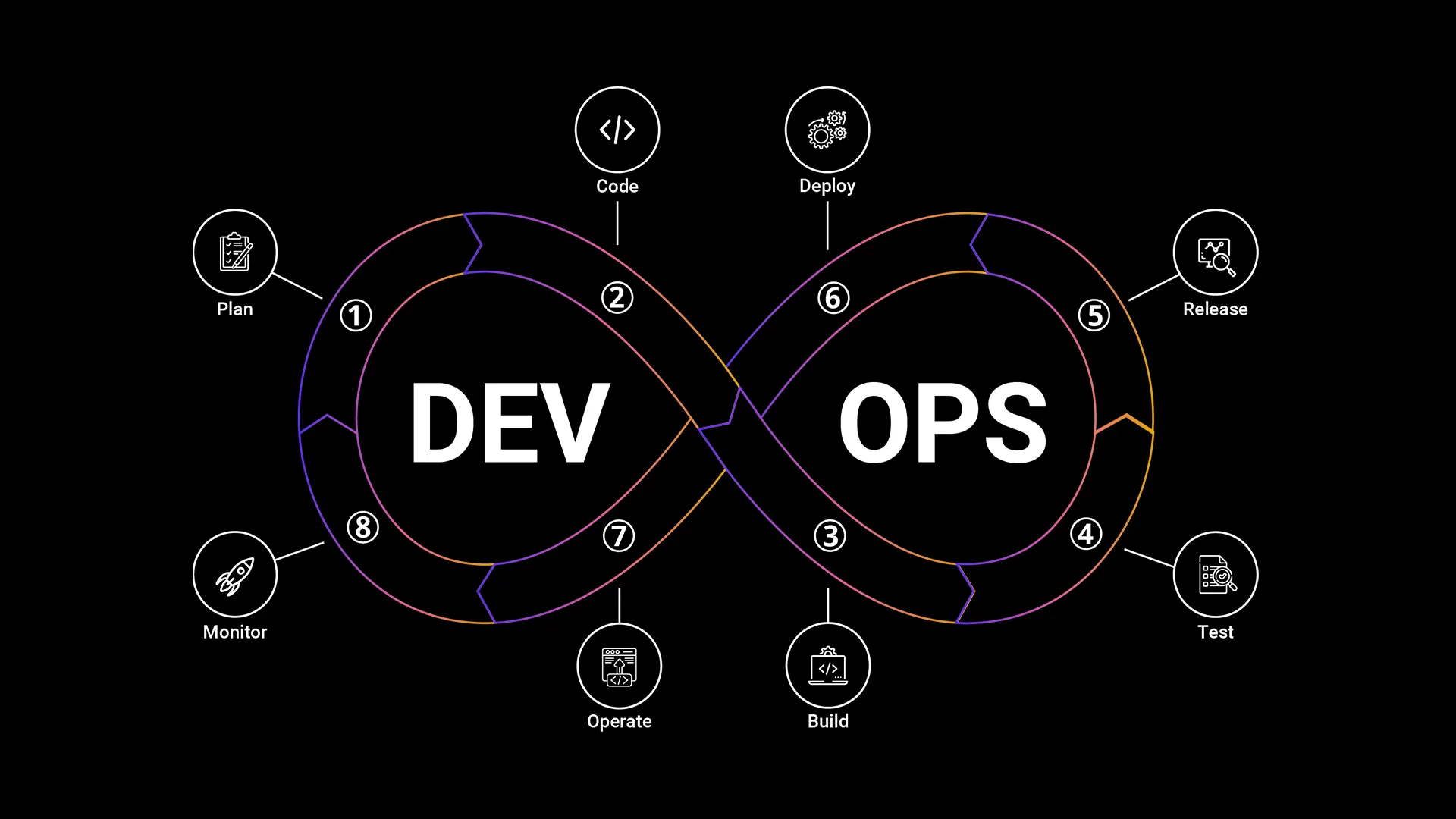In the fast-paced world of software development and IT operations, the ability to deliver applications and services quickly, reliably, and at scale is paramount. The traditional silos between development and operations teams often create bottlenecks, leading to slower releases, increased errors, and frustrated teams. This is where DevOps methodology provides a framework by fostering collaboration, communication, and integration between development and operations teams. A cornerstone of this approach, and arguably its most impactful element, is DevOps automation.
This blog post will explore what DevOps automation entails, why it’s essential for modern IT, its key benefits, different areas where it’s applied, and some best practices for implementation.
What is DevOps Automation?
What is DevOps Automation?
Let’s break it down
What is DevOps?
DevOps, it implicitly refers to the broader methodology. Think of DevOps as a cultural and operational shift aimed at breaking down the traditional silos between development (Dev) and operations (Ops) teams. The goal is to foster collaboration, communication, and integration throughout the entire software lifecycle. This collaboration helps teams build, test, release, and maintain software more quickly and reliably. It’s about shared responsibility and working together to achieve business goals.
What is Automation?
Automation, in a general sense, is the use of technology to perform tasks with minimal human intervention. In the context of software and IT, it’s about using tools and scripts to execute repetitive tasks programmatically. Instead of someone manually clicking buttons, running commands, or configuring settings every time, automation sets up a system to do it automatically and consistently. This reduces the chances of human error and speeds up processes.
Connecting DevOps and Automation: What is DevOps Automation?
Now, let’s connect the two. DevOps automation is the practical application of automation principles within the DevOps framework. It’s “the practice of automating repetitive tasks and workflows throughout the software development lifecycle (SDLC) and IT operations processes.”
Because DevOps emphasizes speed, reliability, and efficiency across the entire pipeline (from writing code to running it in production), automation becomes the engine that makes this possible.
- Development Side: Automation is used for things like automatically compiling code whenever changes are made, running automated tests to catch bugs early, and packaging applications for deployment.
- Operations Side: Automation handles provisioning infrastructure (setting up servers, databases, etc.), configuring those systems consistently, deploying applications to different environments, and monitoring systems for performance and issues.
- Connecting Dev and Ops: Automation builds the bridges between these teams. Automated pipelines (like CI/CD) trigger actions automatically as code moves through the process, reducing manual handoffs and potential delays or errors.
In essence, DevOps provides the “why” – the need for faster, more reliable software delivery through collaboration – and automation provides the “how” – the tools and techniques to make those processes efficient, repeatable, and less prone to error. DevOps automation is the key mechanism that allows teams to achieve the core objectives of the DevOps methodology.
At its core, DevOps automation refers to the practice of automating repetitive tasks and workflows throughout the software development lifecycle (SDLC) and IT operations processes. This includes everything from code compilation and testing to infrastructure provisioning, configuration management, deployment, and monitoring.
Instead of relying on manual steps that are prone to human error and inconsistency, automation leverages tools and scripts to execute these tasks programmatically. The goal is to create a streamlined, efficient, and repeatable pipeline that allows teams to build, test, and release software with greater speed and confidence.
Benefits of DevOps Automation
Implementing DevOps automation yields a multitude of benefits for organizations:
- Increased Speed and Frequency of Releases: Automating build, test, and deployment processes allows teams to release software more frequently and rapidly, responding quickly to market demands and customer feedback.
- Reduced Human Error: Manual tasks are a primary source of errors. Automation ensures that processes are executed consistently every time, significantly reducing the risk of bugs and misconfigurations.
- Improved Reliability and Stability: Automated processes are repeatable and consistent. This leads to more stable build, test, and deployment environments. Reduced manual intervention means fewer errors, less configuration drift, and a more predictable infrastructure, resulting in fewer production issues and greater system reliability.
- Lower Costs: By reducing manual effort and minimizing errors and downtime, automation can lead to significant cost savings over time.
- Enhanced Collaboration: Automation provides a shared, transparent view of the pipeline, fostering better collaboration between development, operations, and other teams.
- Faster Feedback Loops: Automated testing and monitoring provide rapid feedback on the health and performance of applications, allowing teams to identify and address issues quickly.
- Better Resource Utilization: Freeing up engineers from repetitive manual tasks allows them to focus on more innovative and high-value work.
- Scalability: Automated processes can easily scale to handle increasing workloads and system complexity.
- Minimizes Duplications: Automation helps standardize processes and configurations, reducing redundant efforts and inconsistencies across environments.
- Provides Proper Guidelines: Automated workflows enforce predefined standards and best practices, guiding teams towards consistent and compliant processes.
- Reduces Risks: By automating repetitive tasks, enforcing configurations, and enabling faster feedback through monitoring, automation significantly reduces the risk of deployment failures, security vulnerabilities, and operational issues.
What are the Different Types of Automation in DevOps?
Automation is applied across various domains within the DevOps ecosystem. Some of the key types include:
Infrastructure as Code (IaC)
IaC involves managing and provisioning infrastructure (servers, networks, databases, etc.) using code and automation tools, rather than manual processes. This allows infrastructure to be treated like application code, enabling versioning, testing, and automated deployment.
How Modulis helps: Modulis’s DevOps Automation (AutoOps) includes capabilities for automating infrastructure setup, ensuring your environment is provisioned correctly and consistently every time, without manual configuration headaches.
Configuration Management
This type of automation ensures that servers and applications are configured consistently across different environments (development, staging, production). Tools are used to define and enforce desired configurations, preventing configuration drift.
How Modulis helps: AutoOps automates the application of security best practices and configurations, ensuring your systems are set up securely from the start and remain compliant.
Continuous Integration and Continuous Delivery (CI and CD)
- Continuous Integration (CI): Developers frequently merge their code changes into a shared repository, followed by automated builds and tests to detect integration issues early.
- Continuous Delivery (CD): Automated processes take validated code changes from the repository and prepare them for release to production.
- Continuous Deployment (CD): An extension of CD, where every code change that passes all stages of the pipeline is automatically deployed to production without manual approval.
How Modulis helps: Modulis’s AutoOps automates the entire process from repository setup through CI/CD, creating a seamless pipeline that minimizes manual effort and accelerates your release cycles.
Continuous Monitoring
This involves continuously monitoring the performance, health, and security of applications and infrastructure in production. Automated tools collect logs, metrics, and traces, providing real-time visibility and alerting teams to potential issues.
How Modulis helps: AutoOps includes comprehensive security and monitoring capabilities, automatically setting up monitoring and providing daily reports and alerts, giving you full-stack observability without manual configuration.
What are the Best Practices for DevOps Automation?
To effectively implement DevOps automation, consider these best practices:
- Start Small and Iterate: Don’t try to automate everything at once. Begin with automating the most repetitive or error-prone tasks and gradually expand.
- Use Version Control: Treat your automation scripts and configuration files like code and store them in a version control system (like Git). This allows for tracking changes, collaboration, and rollback capabilities.
- Build a Culture of Automation: Encourage all team members, both developers and operations personnel, to embrace and contribute to automation efforts.
- Monitor Your Automation: Just as you monitor your applications, monitor your automation pipelines and tools to ensure they are running smoothly and effectively.
- Document Everything: Clearly document your automated workflows, scripts, and configurations to ensure knowledge sharing and maintainability.
- Prioritize Security: Integrate security practices throughout your automated pipeline, including automated security testing and vulnerability scanning.
- Measure and Improve: Track key metrics related to your automation efforts (e.g., deployment frequency, lead time, mean time to recovery) to identify areas for improvement.
Conclusion
DevOps automation is a transformative practice that is essential for organizations seeking to improve the speed, reliability, and efficiency of their software delivery. By automating repetitive tasks across infrastructure, configuration, CI/CD, and monitoring, teams can minimize errors, reduce risks, enhance productivity, and deliver higher-quality software to users faster. Embracing automation is not just about using tools; it’s about adopting a mindset and a set of practices that drive continuous improvement throughout the entire IT lifecycle. As the complexity of software systems grows, automation will continue to be a critical factor in achieving DevOps success.
Modulis’s platform provides a comprehensive suite of tools, including robust DevOps Automation (AutoOps), ready-made modules, and monitoring, designed to help you accelerate your development journey. From automating your infrastructure setup to providing full-stack observability, Modulis empowers you to build faster, launch sooner, and scale effortlessly.
Ready to experience the power of DevOps automation?



